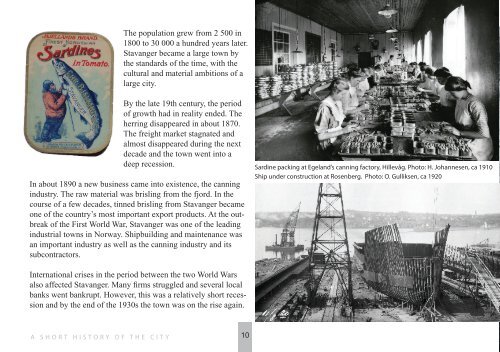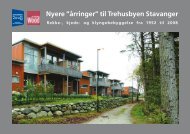Stavanger kommune
Stavanger kommune
Stavanger kommune
You also want an ePaper? Increase the reach of your titles
YUMPU automatically turns print PDFs into web optimized ePapers that Google loves.
The population grew from 2 500 in<br />
1800 to 30 000 a hundred years later.<br />
<strong>Stavanger</strong> became a large town by<br />
the standards of the time, with the<br />
cultural and material ambitions of a<br />
large city.<br />
By the late 19th century, the period<br />
of growth had in reality ended. The<br />
herring disappeared in about 1870.<br />
The freight market stagnated and<br />
almost disappeared during the next<br />
decade and the town went into a<br />
deep recession.<br />
In about 1890 a new business came into existence, the canning<br />
industry. The raw material was brisling from the fjord. In the<br />
course of a few decades, tinned brisling from <strong>Stavanger</strong> became<br />
one of the country’s most important export products. At the outbreak<br />
of the First World War, <strong>Stavanger</strong> was one of the leading<br />
industrial towns in Norway. Shipbuilding and maintenance was<br />
an important industry as well as the canning industry and its<br />
subcontractors.<br />
Sardine packing at Egeland’s canning factory, Hillevåg. Photo: H. Johannesen, ca 1910<br />
Ship under construction at Rosenberg. Photo: O. Gulliksen, ca 1920<br />
International crises in the period between the two World Wars<br />
also affected <strong>Stavanger</strong>. Many firms struggled and several local<br />
banks went bankrupt. However, this was a relatively short recession<br />
and by the end of the 1930s the town was on the rise again.<br />
A SHORT HISTORY OF THE CITY<br />
10
















